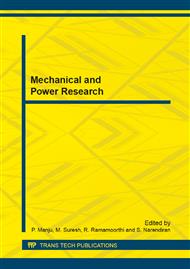[1]
F. C. C. Spectrum policy task force report, IEEE Trans. Information Forensics and Security. p.02–155, (2002).
Google Scholar
[2]
F. C. C. 2008. In the matter of unlicensed operation in the TV broadcast bands. Second Report and Order and Memorandum Opinion and Order. 08-260A1, (2008).
Google Scholar
[3]
Bazelon.C. 2008. Licensed or unlicensed: The economic considerations in incremental spectrum allocations. New Frontiers in Dynamic Spectrum Access Networks, 2008. IEEE Symposium 3: p.1–8, (2008).
DOI: 10.1109/dyspan.2008.66
Google Scholar
[4]
Tai-hoon Kim, Wai-Chi Fang, Carlos Ramos, Sabah Mohammed, Osvaldo Gervasi, Adrian Stoica, Ubiquitous Sensor Networks and its applications, 1-3, (2012).
Google Scholar
[5]
Mitola, J. and J. Maguire, G.Q. 1999. Cognitive Radio: making software radios more personal. Personal Communications, IEEE 6: p.13–18, (1999).
DOI: 10.1109/98.788210
Google Scholar
[6]
Akyildiz I.F. 2006. Next generation/dynamic spectrumaccess/cognitive radio wireless networks: a survey. Computer Networks 50: 2127–2159, (2006).
DOI: 10.1016/j.comnet.2006.05.001
Google Scholar
[7]
F.H. Tseng, LD Chou, HC Chao, A survey of black hole attacks in wireless mobile ad hoc networks. Human-centric Computing and Information Sciences 1 (1), 1-16, (2011).
DOI: 10.1186/2192-1962-1-4
Google Scholar
[8]
Stevenson C.R. IEEE 802. 22: The first cognitive radio wireless regional are network standard. IEEE Communication Magazine, (2009).
Google Scholar
[9]
IEEE 802. 22 WG. 2006. IEEE p.802. 22/d0. 1 draft standard for wireless regional area networks part 22: Cognitive wireless ran medium access control (MAC) and physical layer (PHY) specifications: Policies and procedures for operation in the TV bands, (2006).
DOI: 10.1109/ieeestd.2011.5951707
Google Scholar
[10]
Nasai Hu, Yu-DongYao, and Joseph Mitola. 2012. Most Active Band (MAB) attack and countermeasures in a cognitive radio network. IEEE Transactions on Wireless Communications 11: pp.898-902, (2012).
DOI: 10.1109/twc.2012.011812.110927
Google Scholar
[11]
Shafiullah Khan, Kok-Keong Loo, Noor Mast, TahirNaeem. SRPM: Secure Routing Protocol for IEEE 802. 11 Infrastructure Based Wireless Mesh Networks. J. Network Syst. Manage. 18(2): pp.190-209, (2010).
DOI: 10.1007/s10922-009-9143-3
Google Scholar
[12]
Bian. K and J. -M. J. Park. 2008. Security vulnerabilities in IEEE 802. 22, WICON '08. Proceedings of the Annual International Conference on Wireless Internet 4: p.1–9, (2008).
Google Scholar
[13]
Clancy. T and N. Goergen. Security in cognitive radio networks: Threats and mitigation. International Conference on, Cognitive Radio Oriented Wireless Networks and Communications 3: p.1–8, (2008).
DOI: 10.1109/crowncom.2008.4562534
Google Scholar
[14]
Chen. R, J. -M. Park, and K. Bian. Robust distributed spectrum sensing in cognitive radio networks. IEEE INFOCOM. p.1876 –1884, (2008).
DOI: 10.1109/infocom.2008.251
Google Scholar
[15]
Chen. R and J. -M. Park. Ensuring trustworthy spectrum sensing in cognitive radio networks. IEEE Workshop on Networking Technologies for Software Defined Radio Networks 1: p.110–119, (2006).
DOI: 10.1109/sdr.2006.4286333
Google Scholar
[16]
Myerson R.B. Game Theory: Analysis of Conflict. Harvard University, (1997).
Google Scholar
[17]
Yi Tan, Sengupta. S and Subbalakshmi, K.P. 2011. Analysis of Coordinated Denial-of-service Attacks in IEEE 802. 22 Networks. Selected Areas in Communications, IEEE Journal 29: pp: 890-902, (2011).
DOI: 10.1109/jsac.2011.110419
Google Scholar
[18]
Sengupta.S. 2008. A game theoretic framework for distributed self-coexistence among IEEE 802. 22networks. In proceedings of IEEE Global Communications Conference (GLOBECOM), (2008).
DOI: 10.1109/glocom.2008.ecp.598
Google Scholar


